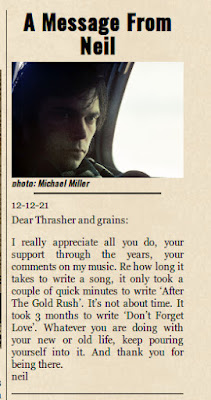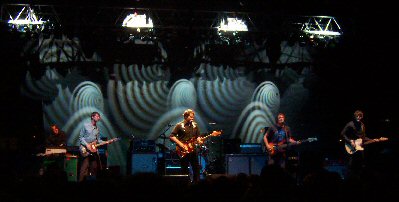The Surrealism of Neil Young's "On The Beach" Album

Neil Young's "On The Beach" album cover is considered to be one of his most creative and intriguing designs in his vast catalog.
It would seem that many of his album covers have a rather tossed off feel. For example, the "Living With War" cover is literally stenciled letters on a brown paper bag. In contrast, "On The Beach" album is meticulously designed right down to the inside of the album jacket matching the pattern of the inside of the umbrella on the cover.
"On The Beach" -- the final link of Neil Young's Ditch Trilogy -- is considered by many fans to be one of his best and their most favorite of all Neil Young album covers and artwork. Designed by Gary Burden, photographed by Bob Seideman, and graphic lettering by Rick Griffin, the cover is quite enigmatic with a Cadillac car fin jutting from the sand like a crashed rocket being buried by time. A shoeless Neil stares out into the ocean near a forlorn potted palm. A jaunty yellow beach umbrella matches Neil's jacket. The yellow theme is even continued with a Coors beer can on the table. Inside the album, things become even more crpytic with the album's liner notes. Fans have poured over Rusty Kershaw's strange handwritten note for clues and meaning often to no avail. Apparently, the recording sessions' heavy use of Honey Slides took a toll ... possibly to the creative sides' benefit?

But probably the most significant item on the cover is the newspaper's headline "Senator Buckley Calls for Nixon to Resign". (Young and Nixon have had a bitter and strange relationship over the years. From "Ohio" 's lyrics "Tin soldiers and Nixon's coming" to "Campaigner's" lines "Even Richard Nixon has got soul", Neil has never made a secret of his feelings towards U.S. President Richard Nixon.)
Which brings us to the rather fascinating article ON THE BEACH – Dali, Ballard, Neil Young and Cadillac Ranch | THE END OF BEING by James Reich.
The article brings together a series of unlikely events in 1974 between surrealist artist Salvador Dali, author J. G. Ballard, and musician Neil Young.
If you're unfamiliar with the post-nuclear apocalypse vision of Nevil Shute’s 1958 novel On The Beach (filmed by Stanley Kramer in 1959), than the article will help place Young's album in some perspective.
Ballard's followup novel The Drought was released in paperback in 1974 with David Pelham's cover art of the tail end of a yellow Cadillac part-submerged into the desert.

James Reich analyzes the connections between the surrealism of Dali, Pelham & Griffin:
Uncannily, Pelham’s yellow Cadillac in the sand resurfaces in July 1974 in psychedelic poster artist Rick Griffin’s cover art for Neil Young’s album On The Beach.
Psychedelic art, even in a generalized sense, is indebted to surrealism, and this image makes specific use of its currency. The image and angle of the Cadillac tail in Griffin’s surreal photograph are strikingly close to Pelham’s illustration, and this is also the work that further binds Pelham’s work to Ballard’s fascination with Dali's The Persistence of Memory.
The melting watches and the dead tree of Dali’s 1931 painting are represented by the forlorn angle of a fringed beach umbrella over the disarray of a cocktail table that Young has abandoned to contemplate oblivion at the limit of the beach. The orange flowers printed on the fabric of the beach furniture, their particular shade and shape allude to Dali’s closed watch, swarmed with ants. The windblown newspaper wrapped about the base of the umbrella (headline calling for the resignation of Richard Nixon which would occur the following month) again marks the end of chronology. Dali’s Catalonian cliffs (absent from Pelham’s image for The Drought) are referenced in the indistinct coastline visible on the right of the record sleeve photograph.
Neil Young’s ragged hair replaces the pubic eyelashes of Dali’s abortive creature on the beach. Alienation and holocaust pervade the album from Young’s solitary abandonment during a radio interview in the title track, to the Manson Family allusions and autogeddon of Revolution Blues: “I got the revolution blues, I see bloody fountains, and ten million dune buggies comin’ down the mountains. Well, I hear that Laurel Canyon is full of famous stars, but I hate them worse than lepers and I’ll kill them in their cars.”
Check out ON THE BEACH – Dali, Ballard, Neil Young and Cadillac Ranch | THE END OF BEING by James Reich.
Thanks Roel!

More on Neil Young On The Beach reviews.
Labels: album, cover, ditch trilogy, neil young, on the beach































 Human Highway
Human Highway

















 Concert Review of the Moment
Concert Review of the Moment





 This Land is My Land
This Land is My Land

 FREEDOM In A New Year
FREEDOM In A New Year









 *Thanks Neil!*
*Thanks Neil!*




![[EFC Blue Ribbon - Free Speech Online]](http://www.thrasherswheat.org/gifs/free-speech.gif)











 The Unbearable Lightness of Being Neil Young
The Unbearable Lightness of Being Neil Young Pardon My Heart
Pardon My Heart



 "We're The Ones
"We're The Ones  Thanks for Supporting Thrasher's Wheat!
Thanks for Supporting Thrasher's Wheat!




 This blog
This blog 
 (... he didn't kill himself either...)
#AaronDidntKillHimself
(... he didn't kill himself either...)
#AaronDidntKillHimself









































































 Neil Young's Moon Songs
Neil Young's Moon Songs




 Civic Duty Is Not Terrorism
Civic Duty Is Not Terrorism Orwell (and Grandpa) Was Right
Orwell (and Grandpa) Was Right


 What's So Funny About
What's So Funny About 



23 Comments:
That album was ahead of it's time and will always be my "Harvest." The songs & ballads are beautiful and provocative.
It was hurled from out of a black hole and traveled through space for many, many years before it landed...
My favorite album and favorite album cover. Thank you.
The connection with Dali really isn't convincing.
Connection?
That's an oxymoron for surrealism in theater, poetry, art, and music.
There is no connection in surrealism due the irrational arrangment of objects, notes, subject matter.
I think Thrasher is only pointing out the disconnection that defines "On the Beach" as "surreal."
If you heard or read how they made that album, it was a "surrealistic" experience for sure.
Sometimes the most beautiful melodies in the world emerges from the loneliness, rejection and despair.
A muse that inspires beauty can also be evil and conniving and tempting.
The muse can be very destructive which is why the "experience" with the muse can also be part of the surreal.
Kapeesh?
Hello Dali...sorry but couldn't resist.
Great story and analysis plus comments. My favorite also along with Sleeps With Angels, which coincidentally (or not) also has a dreamlike cover. Of course there are a number of other albums close behind in my "favorites" list.
I remember watching the film version of On The Beach many times as a youngster (it was a regular on Million Dollar Movie Matinee on WPIX) and always found it compelling and scary in equal measures (kind of the definition of "art" in a way). With Gregory Peck, Ava Gardner, Fred Astaire and Tony Perkins in starring roles and direction by Stanley Kramer, it remains a favorite of mine to this day.
I remember feeling a very strong connection when Neil's album first came out and how it just seemed so different, even for that period. And the cover art just added to the whole experience: is that a rocket ship in the sand? who drank the Coors? The mood that it sets is one that's very familiar now along with the question of how to live when time is running out. I'm a fan of the TV show Walking Dead, which depicts an equivalent world...except that now,even "life" and "death" is not so clear cut.
Thanks for the story and comments which I greatly enjoyed!
I tried to kill the pain
Bought some wine and hopped a train
Seemed easier than just
Waitin' around to die
--Townes Van Zandt
Sort of weird to be invited by a guest with his back to you and sit at a table on the beach where the ocean vista is obscured from view. We're only permitted to hear the waves roaring but we can't see it. Sort of like how Lps are made. You can hear what the musicians wants you to hear, but you can't see it happening.
Which brings me to the valuable video footage of "Alabama" being performed. When I first heard that song, it was sensory overload. After all these years, I finally understand why.
When I see the juxtaposition of the musicians, the sound that escaped through the barn seams, it all made perfect sense how such a song could have such a sensory overload not only for it's meaning, but for how it was recorded...
The album cover also inspired an interesting t-shirt design from Rotter and Friends...
Some interesting comments on surrealism. This whole thread is kinda surreal...
Just updated post with the OTB poster with Neil facing camera which somehow puts the whole cover ina different context.
Here we have Neil smiling. Probably laughing about how surreal it is to concoct the whole setup for an album cover.
If you asked Neil, he would probably say that whole time period was surreal. Don't read too much into it because had he continued on that path, he would have been found dead somewhere.
Pegi pulled him out of the maelstrom of craziness and the surreal, breathed new life into him, and gave him a second look at life.
Perhaps only marginal, but when I first bought the album, I thought that THE COOLEST THING EVER was to have the cheesy floral-print matching the tawdry beach-furniture, printed on the INTERIOR of the cover sleeve.
Pure brilliant.
-- Eric
Great stuff, thanks! Makes "On the Beach" (and 1974) feel almost as depressing as back then. By the way, if you're innarested in Neils 1974 world view, a nice read is "Patty's Got A Gun. Patricia Hearst in 1970s America" by William Graebner (University of Chicago Press, 2008). Good diagnosis of societal Angst, obsessions and shifts in morality, from the Sixties to Reagan. Patty, of course, being an inspiration for gun-toting feminist Milly in "Pushed it over the End".
"On The Beach" depressing? 1974 depressing?
Why do you say that?
A bunch of guys were having the time of their life. They had total carte blanche with absolutely no accountibility for their actions.
Neil went to the very edge of the cliff. Sure, some folks actually went over the cliff and never made it back; is that what you're referring to? Depressing because things were way out of control there?
One of the most beautiful ballads that emerged from that time was "Ambulance Blues" and "For the Turnstiles." Another great song that emerged "Time Fades Away." I don't think those songs are the least bit depressing.
Neil creates the setting in his songs. He's telling you like it was. Next, he's saying, "Hey, don't get buried in the past, man. Move on. Walk with me a while." When he drops you off, that's it. He expects you to succeed and to move on without his help. You know?
That's been his mantra ever since he came into this understanding about life and people in general.
I wouldn't say that's exactly depressing.
If you listen to his words, to what he's singing, he's devising his exit plan the entire time because he knows the destructive nature of the muse. His body would have been ravaged...
@MNOTR - nice seeing you back in action here on TW. You always have such cogent comments.
While it doesn't seem like '74 was that long ago, it truly was a different time & spirit.
Comparatively speaking, things seemed freer and open even when folks seemed to be operating on a lower level of awareness of true reality.
Today, with all of our internets and open flow of info, it seems that the mainstream is more narrow than ever. Where are the Dali's, Ballard's and Young's of today?
Are they out there and we can't see them & hear them? Or has everything truly creative & groundbreaking been totally repressed?
You seem to think "depressing" is a put down. Why?
I think 'On the Beach' is a GREAT album, by itself and as part of the awesome 'Ditch Trilogy'.
But not depressed? Come on, it's right up there with other Great Depressed Albums (e.g. Lou Reeds "Berlin').
Apart from the funky opener, the feel of the album is down and dark ("Burn outs stub their toes on garbage pails/ Waitresses are cryin' in the rain"), resigned("Though my problems are meaningless/ That don't make 'em go away"), sometimes apocalyptic ("The world is turning/ I hope it don't turn away", and yeah, the Manson line: "But I hate them worse than lepers/ And I'll kill them in their cars".
Sure, some glimmers of hope shine through ("I'm deep inside myself/ But I'll get out somehow', "So all you critics sit alone..."). Yeah, you're right on that one, there's the will to move on in Ämbulance Blues'. You can almost feel Neil pulling himself slowly out of the quagmire...
And that's 'just' the lyrics.. Listen to the music. Neil's tired, heartrending solo on the title track is enough to make Dick Cheney cry (well, that's a strange comparison.. but anyway, you get what I'm trying to say..).
My point being, 'On the Beach' is an intense piece of work, coming from a weary artist, struggling to get to a better place somehow - so don't put it down as just a bunch of guys having a lot of fun back in the days.
LOL - So Jimmy McDonut's account of the album is not accurate? A drunken-doper stupor with playboy bunny-types in and out of the picture?
Tying one single state of emotion like "depressing" isn't exactly accurate, either.
Well, yeah, let's quote ol'Jimmy McDonut. This is what he has to say about 'On the Beach': "Doom and gloom are everywhere on the album, the singer sounding gutted and absolutely alone."
I think that's right on the mark.
And here's what Neil himself says about the album, quoted by Cameron Crowe (also in McDonut): "Probably one of the most depressing records I've ever made.."
Depressing? Are you serious?
Well, who am I to diasgree with the man himself..
By the way, sure they were living it up in 1974, and during the sessions for 'On the Beach'(if you wanna call getting desperately stoned living it up), but what does that have to do with the feel of the album? I don't think an artist has to be crying while recording a sad song..
Anyway, this is Neils answer to McDonuts question if making 'On the Beach;' was fun: "I don't know if 'fun' is the right word. It's a pretty dark record."
That said, McDonut also, correctly I think, notes "there is something subtly uplifting about the album" -glimmers of hope.
As I said, it's a great piece of art - we can agree on that one!
By the way, I also agree that continuing on that road possibly, probably, would've meant the End for Neil, someway somewhere. I don't know where Pegi comes in, biographically (anyway, that's private). But "Zuma" signaled the end of a long dark period, Neil once said. Well, you can hear it on that one, too.
I see what you mean, POC, it can be depressing to look back on your life (or to carefully reconstruct your actions from the previous year as in the case with Cameron's interview in 1975).
Certainly Neil has the gift of hindsight & bullshit reviewing his life in 1975 while talking to Cameron.
Oh yeah, moving to Malibu -- getting away from Carrie and that depressing scene at his No. California ranch was just what the doctor ordered!
In his interview 25 years later with McDonut on page 470, he's very subtle talking about the artistic maelstrom of the "On the Beach" vs. depressing time when he says, "I was on a roll. Didn't really have much time to make me think twice."
Sorry Neil, you can't take "On the Beach" out of the equation here and get away with saying "I was on a roll."
There are a lot of subtleties about Neil, what he's thinking & what he's saying that go right over McDonut's head.
It's been a long, long time since I read that interview between Cameron & Neil but I do remember the day it came out because I was a voracious reader of RS until 1976. My impression of Neil from that article, "Bullshit. These boys want their cake and eat it, too!"
The On The Beach "poster" shown is a magazine add with the songs at the bottom. The record store promotional large poster just has the Reprise and promo info at the bottom...FYI.
I always tied this album cover to a rebirth in Neil's attitude. My favorite song for a long time was "Last Trip to Tulsa." When I first saw the cover and bought the album, I immediately thought he was referencing the last verse: He said, "go get lost" and walked towards his Cadillac. I chopped done the palm tree and it landed on his back." To me this cover was Neil saying that he was over the dark period and ready to take on the world alone - like he did by putting out that first solo record.
Oh, I see. I suppose it was to take the edge off because everyone was having shitfits over Revolution Blues.
Nothing like a good marketing campaign ...
Bart,
A new outlook goes about as far as what you see on the album cover or in the slick advertising they used to promote Neil's album to give that "appearance" that he really didn't mean to sing "and I'll kill the in their cars."
I don't think Neil really makes that 180 until after his son Ben is born. Until he makes a full commitment to his new wife & sons.
Having a child with special needs changes you whether you like it or not. Some people fight the change or pretend that it's not happening. Ben Young was born with magical powers -- didn't you read what Pegi says about him?
We can't dissect Neil or strip his psyche down to find out why he did what he did or look at the impact of the "muse" on his career.
All we can do is look and feel the music & the words written by a man going through transformation in perpetual motion becoming the sum total of all the people he truly loves in the world.
Post a Comment
<< Home